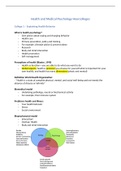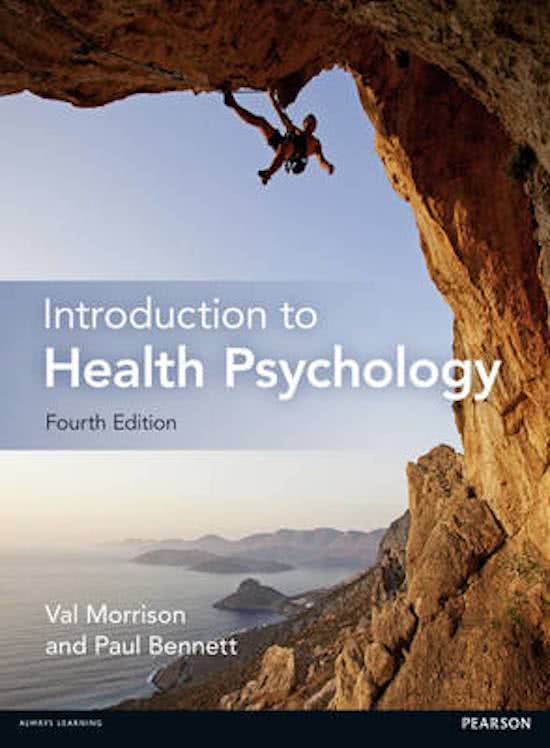Health and Medical Psychology Hoorcolleges
College 1 – Explaining Health Behavior
What is health psychology?
- Give advice about coping and changing behavior
- Health care
- Primary prevention, policy and training
- For example, Lifestyle advice & prevent obese
- Research
- Body and mind interaction
- Health promotion
- Self-management
Perceptions of health (Blaxter, 1990)
- Health as function = you are able to do what you want to do
- Global aspects: health is personal (you choose for yourself what is important for your
own health), and health has many dimensions (physic and mental)
Definition World Health Organization:
- “Health is a state of complete physical, mental, and social well-being and not merely the
absence of disease or infirmity”
Biomedical model
- Underlying pathology, neural or biochemical activity
- For example, Poor immune system
Predictors health and illness:
- Your health behavior
- Stress
- Social environment
Biopsychosocial model
- Interaction!
- Overlap: Health
- Body and mind interaction
,Prevention
- Primary prevention: focus on healthy people who do not yet have health complaints
Promote a healthy lifestyle, for example: Quit smoking, stimulate healthy food and
sports
- Secondary prevention: focus on early, reversible symptoms or people who are at
high risk for a certain illness screening, (healthy) people
- Tertiary prevention: prevention of worsening of the symptoms, this prevention is
about ill people
Cohort studies
- Framingham heart study: 5000 participants, people gave information about their
health every 2 – 6 years results: high blood pressure and unhealthy eating
patterns & health are related to health problems and hart problems
- Alameda study: there are 7 factors for longlivity: exercising, drinking less than 5
drinks in 1 sitting, sleep 7-8 hours at night, no smoking, a normal weight, avoid snacks
and eat breakfast
Types of health behaviors
- Health risk behaviors = behavior pathogens: drinking, smoking, sex without
protection
- Health protective behaviors = behavioral immunogens: good nutrition, enough
sunlight, activity, vaccinations etc.
Why encourage a healthy lifestyle?
1. Health and health behavior is related to life expectancy, morbidity and mortality
2. Socio-demographical differences: low SES live shorter than high SES (on average 6
years). Some interventions do not work for low SES people the differences
become greater
3. The prevalence of risk behaviors: many people drink too much alcohol; a lot of
people smoke there is enough to be done!
4. Health behavior is not always an informed choice our behavior is influenced by
our environment (for example: When your parents smoke, you are more likely to
smoke too when you are older) changing environments may change health
behaviors
Reduction in mortality due to vaccinations, better nutrition and antibiotics
Main causes of death in USA
- First infections, now hearth disease and cancer
- This is related to lifestyle!
,Adverse effects
- Interventions may generate inequalities and make the gap bigger between low and
high SES
- Hardening: don’t trust the government about the health advice they give
- Stigmatizing: we don’t want people with unhealthy lungs or obese to be stigmatized
Getting motivated (HBM, SCT, ToPB)
- You need to be informed about the consequences of a certain behavior
- It is related to how important something is to you
- Are you able to do it?
Health belief model
- Central: perceived threat, based on the perceptions of the perceived susceptibility
(am I likely to get it?) and severity (of a negative outcome, how bad is it?)
- Behavior evaluation: what will happen if you do something, what are the benefits of
performing the behavior?
- General health motivation: how important do you find your health in general?
- All these factors influence the action
Social cognitive theory – self-efficacy!
- Learning theory
- Outcome expectations: for example, reduce stress, feel better
- Most important in this model: self-efficacy = am I able and motivated to perform the
behavior at a level of the desired outcome? (one of the most predictive things of
health behavior), our own confidence in our own behavior
- 4 underlying aspects of self-efficacy expectation: 1. mastery experiences (= what did
you do in the past? (Previous success gives motivation) 2. Vicarious experiences (=
feel that you are able to perform a certain behavior if you see that other people in
your environment are also capable of it) 3. Verbal persuasion (= other people (or
yourself) can convince that you can do it) 4. Emotional arousal (= how you feel about
a certain behavior, can be a source of self-efficacy)
, Theory of planned behavior / theory of reasoned action / reasoned action approach
- In the picture reasoned action approach
- Behavior is the product of our intentions, our intentions are predicted by our
attitudes (overall evaluation), instrumental (= positive and negative consequences)
and experiential attitudes (= how you think you will experience the outcome)
- Perceived norms = beliefs, influences of the social environment, what do other
people expect me to do?
- Injunctive norms (= what other people think we have to do, for example: ‘you should
get vaccinated’) and descriptive norms (= description of what other people around
you are doing, who are important to you the influence is stronger when you
identify more with this people)
- Related to self-efficacy what are my abilities? Do I have control over the behavior?
Can I make a change?
- Intentions (BUT: good intentions are not per se a good predictor of health behavior!)
Self-determination theory
- Focusses on the source of motivation
- Attitudes, norms, deals with the level of motivation
- Does not deal with the content of the motivation
- 3 basic needs: feel connected, feel confident, feel autonomous – related to
motivation
- More intrinsic motivation: people are more likely to stick with their behavior






